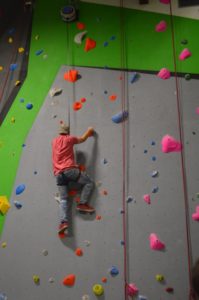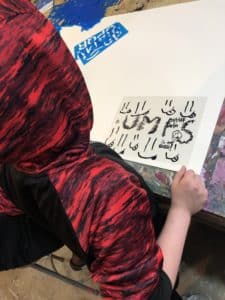Rock climbing, running marathons, and yoga: These are just a few of the ways UMFS Recreation Therapist Liz Creasman is engaging with young people at UMFS. The Recreation Therapy program is bringing activity and excitement to residents at the UMFS Child & Family Healing Center. Many thanks to Liz for joining us as a guest blogger and explaining the therapeutic benefits of recreation therapy. You can follow her adventures on Instagram: @flowtheoryrva
What is Recreation Therapy and how does it benefit residents in the UMFS Child & Family Healing Center?
The National Council for Therapeutic Recreation Certification (NCTRC) describes Recreation Therapy as “a systematic process that utilizes recreation and other activity-based interventions to address the assessed needs of individuals with illnesses and/or disabling conditions, as a means to psychological and physical health, recovery and well-being.” The NCTRC provides credentialing internationally for the Recreation Therapy field. The process referenced includes assessment, planning, implementation, evaluation and documentation. Catering this process to the needs of our residents provides the means to improve quality of life.
I became interested in Recreation Therapy while working at a nonprofit summer camp that provided a scholarship program to increase accessibility and diversity. I earned my Bachelor’s degree in Recreation and Tourism Studies with a focus in Recreation Therapy and a minor in Studio Art. In 2017, I completed training to become a yoga instructor. Combining my passion for empowering teenagers, background in mindfulness-based practices, exploration of community resources, and experience in nonprofit efforts has been a fulfilling experience at UMFS. 
Upon a resident’s arrival to our program, I conduct an initial assessment to gauge leisure and social skills. This assessment includes interests and routine leisure activities. Through discussion and interview style, I am able to build rapport and provide an opportunity for the youth to advocate for individual leisure interests or needs. This tool allows me to effectively plan interventions to address lagging skills.
Through UMFS’ 24-7 Curriculum, I have been focusing on establishing leisure and recreation programming to provide a balanced routine. As a steering committee, we have created the theme “Saturday is the Best Day and Sunday as the R.E.S.T. Day” as a framework to teach leisure planning and implementation skills of our residents and staff. Saturdays are focused on intentional fun to improve time management, community integration, and positive experiences between staff and residents. To create the Sunday framework, the committee created the acronym R.E.S.T., which stands for Restore, Energize, Spirituality, and Togetherness. We have been able to establish several community partners in order to build on our program offerings. I focus on creating community partners that prioritize accessibility and foster a supportive environment for our residents to learn.
I am fortunate to have a supportive team at UMFS, as well as in our surrounding community. Each team member understands the importance of recreation in the lives of our youth. The Safe Socialization Committee has been established to address the needs of the residents to have safe opportunities for interacting with other peers. Monthly, we plan and facilitate a special event based on client interests and cultural awareness. I facilitate group sessions with each small group weekly to specifically target skill building and group dynamics. These sessions are thoughtfully planned in order to suit emotional, spiritual, cognitive, and social needs of the group and individuals. The modalities I use include experiential, athletic, creative expression, and community integration.
 In collaboration, I collect feedback from residents and staff in order to evaluate the effectiveness of the interventions from several perspectives. My observations are recorded for future reference. Individual documentation is completed on each resident in order to evaluate and communicate progress on treatment goals. I am actively involved in weekly treatment team meetings, green light meetings, and collaborations in order to contribute and learn from the support team. These initiatives allow us to creatively address client needs.
In collaboration, I collect feedback from residents and staff in order to evaluate the effectiveness of the interventions from several perspectives. My observations are recorded for future reference. Individual documentation is completed on each resident in order to evaluate and communicate progress on treatment goals. I am actively involved in weekly treatment team meetings, green light meetings, and collaborations in order to contribute and learn from the support team. These initiatives allow us to creatively address client needs.
Safety and Adventure are key components of the Circle of Courage we use in our treatment model. Each activity incorporates these components in order to sustain a supportive milieu to improve quality of life. Increasing leisure awareness and social skills allows for improved relationship building and community integration. Increasing these skills promotes self-esteem and future planning.
